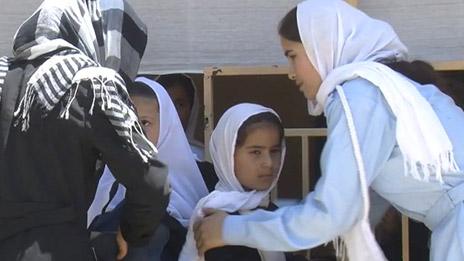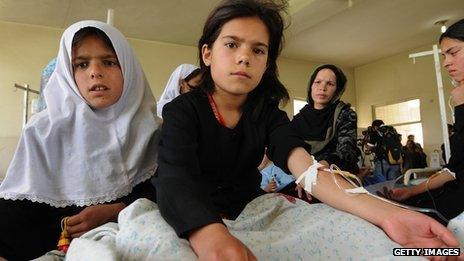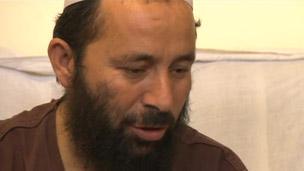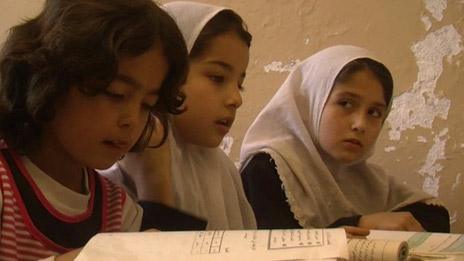Afghans fear mysterious school 'poisonings'
- Published

A mysterious wave of sickness has affected a number of schools in Afghanistan. Hundreds of schoolgirls have been taken to hospital, and many teachers and officials suspect poisoners are to blame. But no poison has yet been found.
At the Bibi Hajera School in northern Afghanistan's Takhar province, the day begins differently now.
The girls arrive in their clean white headscarves, but before they enter the classroom, their teachers search them. Each girl is patted down, even the smallest, and their schoolbags are opened and inspected.
On 23 May, class after class fell ill. By the end of the week, more than 40 were sick, and the school closed. Deliberate poisoning of the school water pump was suspected.
"First one or two of the girls was sick, then more," said Naziah, who hasn't reached her teens and wants to become a doctor one day.
"One of my classmates was in the school garden and she fell down and they took her to hospital. Some were sick on the street, some were sick at home."
The school principal, Abdul Hai, has no doubt that an attack was to blame.
"Outside interference was responsible, the Afghan Taliban aren't sophisticated enough to develop poisons. This was caused by the enemies of Afghanistan and our government," he said.
The school had received no threats, no warnings that it would be targeted, he added.
All summer long, local and international television channels have broadcast updates of the suspected attacks. Girls fell sick in other provinces too - Khost, Bamiyan and Nangarhar.
The pictures are disturbing - young girls in hospital beds with drips attached, some wailing, others fainting.
At times local officials have given conflicting information - that the sickness was caused by poisons, then blaming mass hysteria. The girls usually left hospital within hours. None has died.

Afghan girls are treated for "poisoning" in hospital north of Kabul in 2009
The images of the young women, in what appeared to be considerable pain and certainly a great deal of distress, have caused outrage. In some incidents the finger of blame has been pointed at the Taliban.
The insurgents, who banned female education during their rule, were obvious suspects, in the view of the Afghan authorities.
The Taliban have denied involvement and issued a statement, attacking the "false allegations of the invaders and their hired media", which were "part of the media war and have no reality".
One of the first attacks was in Rustaq village in Takhar province. Five separate water samples were taken from, in and around the Dabiristan Girls High School by the Ministry of Public Health. No soil or air samples were taken.
But Afghanistan doesn't have the technology to analyse the results itself, so the international mission in Afghanistan, Isaf, sent the samples to a laboratory outside the country. There was no trace of anything suspicious.
"Only naturally occurring bacteria was found - no evidence of toxins," said Isaf spokesman, Lt Col Jimmie Cummings.
But girls continued to fall ill. Parents demanded answers, and action, from the government.
Some 31 samples are now being tested in the lab, from other suspected poisonings. The results are expected in the coming weeks.
By early June, 14 suspects had been arrested and transferred to a prison in Kabul, run by the Afghan intelligence agency, the NDS.
But most of those held have been released, but earlier this week, I was invited inside to meet three of the remaining suspects.

Coached by an intelligence officer, Najibullah tells the BBC he gave bottles of poison to two girls
There was no lawyer present. And before the interview with each prisoner began, an officer from the intelligence service (NDS) gave him brief directions on how to answer.
The three are accused of being a supply chain that brought two bottles of poison from Pakistan, via Kunar province, to Takhar. They are suspected of carrying out as many as six attacks, including the one on Bibi Hajera school.
One suspect, Najibullah, a school teacher himself, told me he gave two bottles of poison and 50,000 Afghanis ($1,000) to two girls, to use. One of the bottles was used.
"It was wrong," he told me, as the NDS looked on. "It was un-Islamic, and it was my fault. I made a mistake."
Another man, Mullah Yakub, admitted being a member of the Taliban. He said he helped transport the liquids used in the attack. The third, Nooragha, denies any involvement.
He said: "It came from Pakistan, but I don't have more information, so how can I explain it? On the radio, the Taliban have denied they poisoned schoolgirls."
The pressure to find the people responsible for hurting the schoolgirls has been enormous. All three men will soon be handed over to the attorney general for prosecution.
And in the absence of any physical evidence of toxins, others question whether the attacks are real.

Shrafudin Azemi, a lecturer in psychology at Kabul University, believes the stresses of years of conflict, and the power of the media, have caused panic among Afghan schoolgirls.
"It's basically a psychological issue - the medical and criminal investigations indicate mental harm, not physical harm, to the victims. Afghanistan has been at war for 30 years, people here are suffering under great stress," he said.
At Bibi Hajera school, all the girls have returned. They are again drinking from the school well, which many still believe was poisoned.
But the evidence is far from solid, the facts puzzling.
There are some here who want to stop girls going to school, but whether they resorted to poisoning is a mystery that, so far, remains unsolved.